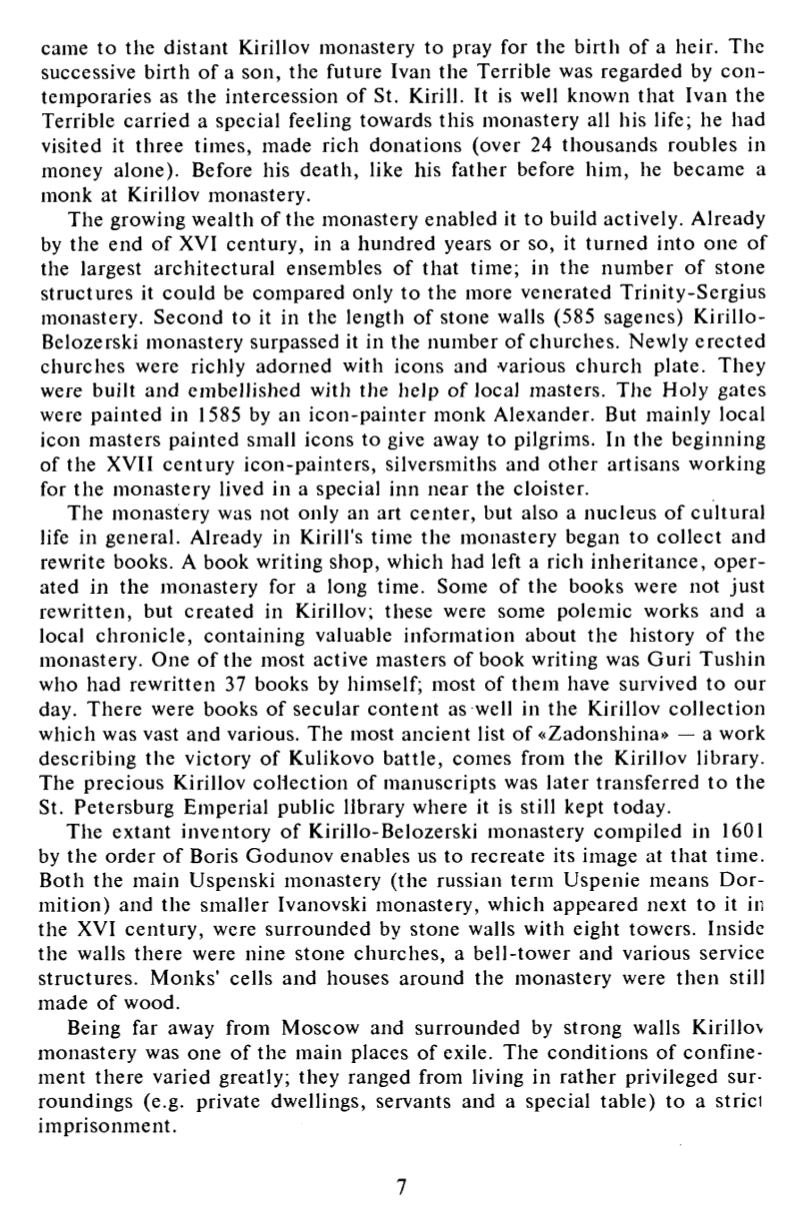

came to the d istan t Kirillov monastery to pray for the b irth o f a heir. The
successive b irth o f a son, the future Ivan the Terrible was regarded by c o n
temporaries as the in tercession o f St. Kirill. It is well known tha t Ivan the
Terrible carried a special feeling towards th is monastery all his life; he had
visited it three times, made rich donations (over 24 thousands roubles in
money alone). Before his death , like his father before him , he became a
monk at Kirillov monastery.
The growing wealth o f the monastery enabled it to build actively. Already
by the end o f XVI cen tury , in a hundred years o r so, it tu rned in to one o f
the largest a rch itectu ral ensembles o f that time; in the number o f stone
structures it cou ld be compared only to the more venerated T rin ity -Serg ius
monastery. Second to it in the length of stone walls (585 sagenes) K irillo-
Belozerski monastery surpassed it in the number of churches. Newly e rec ted
churches were richly adorned with icons and various chu rch plate. They
were built and embellished with the help o f local masters. The Holy gates
were pa in ted in 1585 by an icon -pa in te r monk Alexander. But mainly local
icon masters pain ted small icons to give away to pilgrims. In the beginning
of the XVII cen tu ry icon -pa in te rs, silversmiths and o ther artisans working
for the monastery lived in a special inn near the cloister.
The monastery was not only an art cen te r, but also a nucleus o f cu ltu ral
life in general. Already in Kirill's time the monastery began to co llect and
rewrite books. A book writing shop, which had left a rich inhe ritance , op e r
ated in the monastery for a long time. Some o f the books were not just
rew ritten , but c reated in Kirillov; these were some polem ic works and a
local ch ron ic le , con tain ing valuable information about the history o f the
monastery. One o f the most active masters of book writing was Guri Tushin
who had rew ritten 37 books by himself; most of them have survived to our
day. There were books o f secular con ten t as well in the Kirillov co llection
which was vast and various. The most ancien t list of «Zadonshina» — a work
describing the victory of Kulikovo battle, comes from the Kirillov library.
The precious Kirillov co llection of manuscripts was later transferred to the
St. Petersburg Emperial public library where it is still kept today.
The ex tan t inventory o f Kirillo-Belozerski monastery comp iled in 1601
by the order o f Boris Godunov enables us to recreate its image at that time.
Both the main Uspenski monastery (the russian term Uspenie means D o r
m ition ) and the smaller Ivanovski monastery, which appeared next to it in
the XVI cen tu ry , were surrounded by stone walls with eight towers. Inside
the walls there were nine stone churches, a bell-tow er and various service
structu res. M onks’ cells and houses around the monastery were th en still
made of wood.
Being far away from Moscow and surrounded by strong walls Kirillov
m onastery was one o f the main places o f exile. The cond itions of co n fin e
m en t there varied greatly; they ranged from living in rathe r privileged su r
round ings (e.g. private dwellings, servants and a special tab le) to a stricl
imprisonm en t.
7















